
Although modern smartphones can produce excellent photos, shooting with the professional video camera is what you need to achieve pro-level results.
Such a highly functional device is a real game changer for anyone who is going to record their first short film, become a vlogger, and record memorable moments.
I've compiled a list and tested the most expensive, cheapest, and popular model (in my opinion).
This test has shown that the Panasonic Lumix S5 II is suitable for recording videos of all genres and performs well in different conditions.

Editor’s Choice: Panasonic Lumix S5 II
Universal Model for All Shooting Scenarios
This camera supports 4K videos at up to 60fps and has different recording modes. It boasts in-body stabilization (IBIS) for capturing videos even without the support. Allows shooting crisp footage in poorly lit spaces.
To define the best video cameras, you’ll need to decide the type of content you are going to shoot.
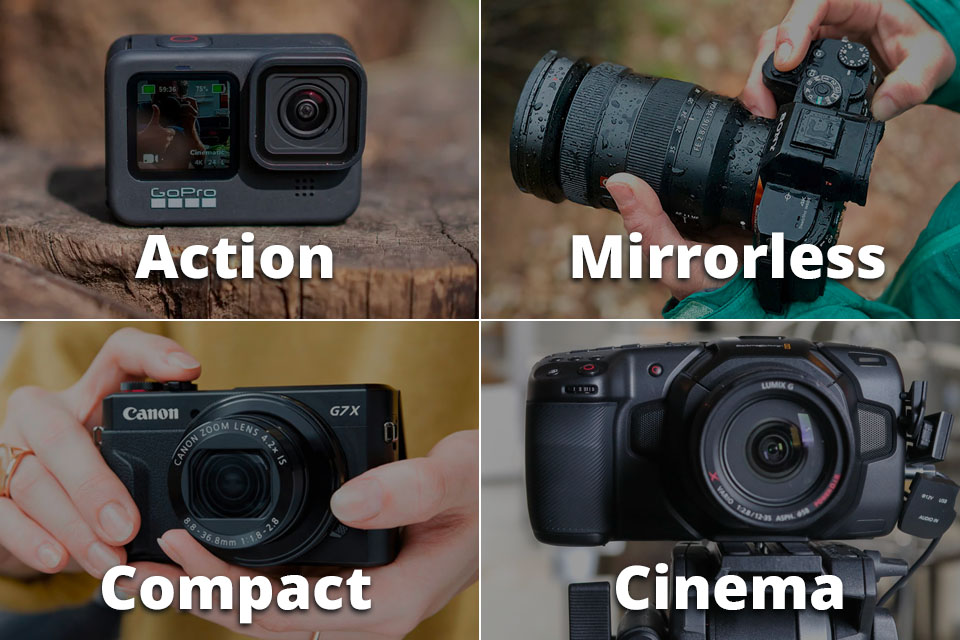
Compact models are the best options for amateurs, but to produce such small devices the engineers had to sacrifice the size of sensors, which resulted in the poorer quality of the recording.
Mirrorless cameras for video is the type I like most. They attract videographers with top-level shooting capabilities, which makes them usable in various shooting scenarios. As a rule, they are not as expensive as cinema cameras – for $700.
Cinema cameras are specifically designed for those who shoot films. The most appealing features of these cameras are high resolution, dynamic range, and pro-level options for cinematic shots.
Action models boast small sizes, rugged, and watertight construction, so they are perfect for shooting in harsh weather conditions. They are perfect for capturing sports activities, filming adventures, and taking dynamic first-person actions.

Type: Mirrorless | Video Quality: 2160p | Max. Frame Rate: 60fps | Resolution: 24.2MP
Panasonic Lumix S5 II is a real boon for videographers who want to produce 4K videos. It offers a myriad of monitoring options and an amazing range of advanced audio functions.
Impressively, this camera can recognize the lens attached and is fitted with a real-time anamorphic desqueeze display. This is a considerable advantage for the professionals who shoot with anamorphic lenses.
Besides, Panasonic beats the competitors by introducing the AF hybrid system that blends phase detection with contrast detection. Of course, it is a big step forward but is not ideal.
There are occasional issues when shooting in poorly lit environments and the speed of detecting the subject might be higher compared to other brands.

Overall, this Panasonic camera is stuffed with many focus modes and video recording formats, which makes it an ideal solution for various types of uses.
This model gets well with gimbals, so it is a great option to produce smooth footage.

Type: Mirrorless | Video Quality: 4K | Max. Frame Rate: 120fps | Resolution: 24.2MP
Sony Alpha ZV-E10 is specifically designed for vloggers and content creators who are new to the field or looking for a compact filming setup.
Another considerable plus of this vlogging camera is its lightweight design, which makes it easy to carry around.
It records fantastic 4K/30p videos with a maximum frame rate of up to 120fps. As an experienced user of the Sony Alpha ZV-E10, I can say with confidence that its dynamic range is solid, even with the kit lens attached.
This is probably one of the best videography cameras, as it is fitted with dedicated models for vloggers, namely 'Blur' or 'Background Defocus' and 'Product Showcase'. They enable switching the focus from the subject to the product that is on showcase.

The slick AF is another great plus. It excels in all the models in this price range. The subject will stay always in focus even without the need to tweak the settings, which makes it an absolutely friendly solution for content creators.

Type: Mirrorless | Video Quality: 6.2K | Max. Frame Rate: 240fps | Resolution: 26.1MP
Fujifilm's X-H2S attracts videographers with a range of resolutions it offers, allowing them to record video in 6.2K quality at 30p and 4K at 120p, though there is a crop factor.
If you usually shoot for a long time, you’ll definitely benefit from the ability to attach an extra cooling fan for additional cooling.
I recorded with this camera model when sailing a Zodiac boat at a high speed, and was amazed by its ability to keep the focus even in such conditions. A long-lasting battery is another considerable advantage, but when the cooling fan is on, it will drain in 20 minutes.

Although the UI is not so complicated, but not as user-friendly as you might wish.
Another drawback is the high price of accessories, but for seasoned videographers looking for a video camera for sports that can capture moving subjects, the X-H2S is definitely worth a purchase.

Type: Mirrorless | Video Quality: 4K | Max. Frame Rate: 120fps | Resolution: 12MP
Sony A7S III is a perfect solution for filmmakers who often shoot in lighting conditions that are far from ideal. It excels in other models by shooting detailed images even in shadows and highlights.
This low-light video camera allows recording in 4K, whereas an array of frame rates and internal codecs, including XAVC S and S-Log, will make your post-production workflow more flexible.
Moreover, it can handle HD at 240p without trouble.
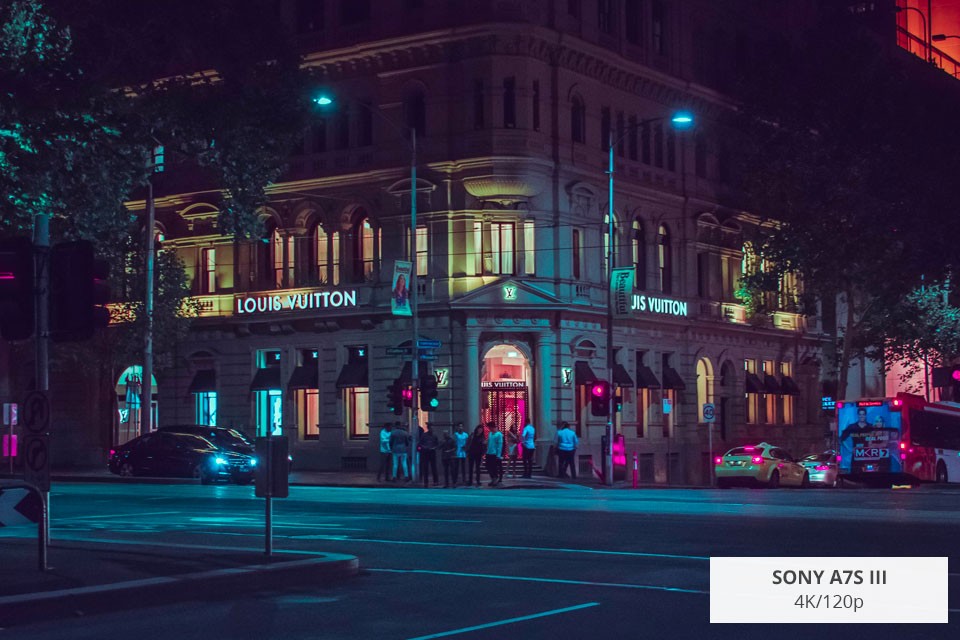
Active Mode for image stabilization is another appealing feature for filmmakers. Of course, it is not the replacement for a tripod, but it ensures decent hand-held performance in smaller rooms that cannot accommodate your gimbal.
Although some users complain about lags in the EVF and occasional issues with the touchscreen, it is easy to solve these problems by installing firmware updates.

Type: Mirrorless | Video Quality: 4K | Max. Frame Rate: 60fps | Resolution: 20.3MP
Live streaming capability is the feature that makes the Panasonic Lumix GH5 the best camera for video shooters on Twitch or YouTube. In addition to wireless live-streaming via Wi-Fi, it can also connect to your smartphone after a trouble-free firmware update.
Its image stabilization system ensures smooth videos in different shooting scenarios. Thanks to this feature, you can achieve pro-level results even when shooting hand-held.

This video camera for YouTube offers high-end recording options that are regularly updated. If you know how complicated post-production color grading could be, you’ll appreciate 10-bit 4K capture and a V-Log L profiles.
Although some lags are reported, GH5 II leverages AI technology to identify faces, bodies, and even animals quickly and accurately, which cannot be said about previous models.

Type: Action | Video Quality: 5.3K | Max. Frame Rate: 60fps | Resolution: 27MP
TikTok bloggers like this camera model for its tall sensor that produces amazing vertical videos, which are ideal for this platform. Not only that, it boasts an ability to shoot at 5.3K and offers interesting Night Effects modes for sprucing up videos.
To make your footage look epic, try to add Star Trails or Vehicle Light Trails. The 'linear + horizontal' Horizon Lock makes sure that the horizons are stable and professional.

Content creators also appreciate the ability to snag 27MP stills right from the footage, as well as the durable battery of this GoPro camera, which can endure the whole trip worry-free.
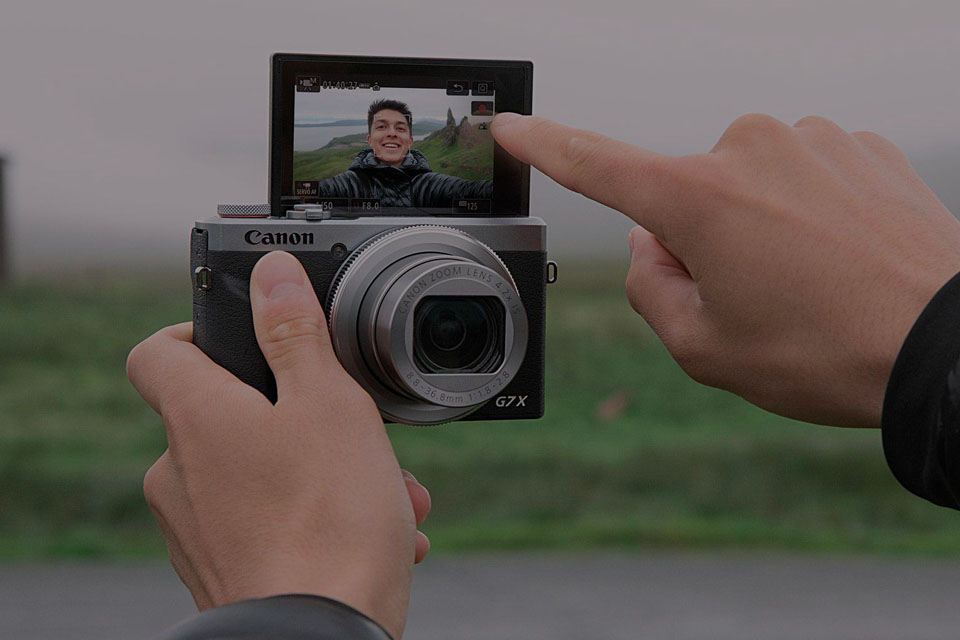
Type: Compact | Video Quality: 4K | Max. Frame Rate: 120fps | Resolution: 20.1MP
Canon PowerShot G7 X Mark III supports 4K 30P and FHD 120P video, so the footage it shoots is always crisp and clear. With this camera, you can record cinematic 4K videos with an impressive slow-mo effect in full HD.
Moreover, it is fitted with 4.2x optical zoom (24-100mm f/1.8-2.8) with excellent IS allowing users to shoot detailed and smooth videos.

Another plus of this Canon video camera is its small size, which makes it an ideal solution for shooters who are always on the go.
Intuitive controls are one of the major benefits as well. Additionally, the camera supports live streaming directly to YouTube without the need to install any extra applications.

Type: Mirrorless | Video Quality: 4K | Max. Frame Rate: 60fps | Resolution: 24.5MP
Nikon Z6 II has a highly functional sensor for shooting crisp and clean footage even at high ISO settings. 4K 60fps mode is really great but you need to keep in mind that it has a 1.5x crop.

Videographers also like the snappy AF of this Nikon camera for video. It also features a high-end eye-detection capability for keeping your subjects sharp.
However, users report occasional lags in AF performance, which is a deal-breaker for some filmmakers.

Type: Mirrorless | Video Quality: 2160p | Max. Frame Rate: 240fps | Resolution: 26.1MP
The Fujifilm X-T4 attracted my attention with the ability to shoot high-speed videos at up to 240 fps. Capturing every, even minor, detail, this camera can demonstrate such actions as the wing clapping of a hummingbird.
Besides, it comes with amazing film simulation modes to make each video project stand out.
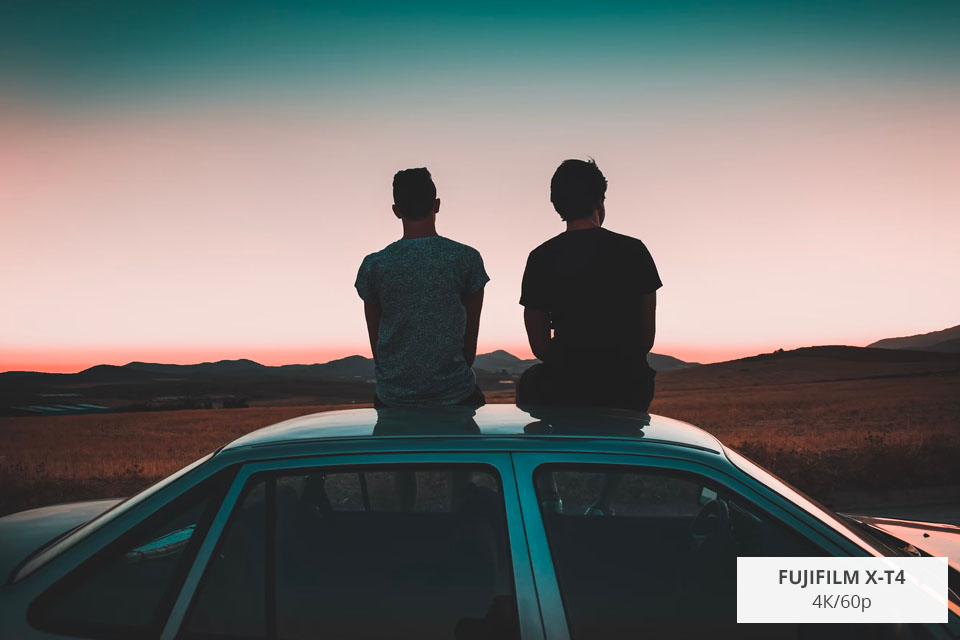
Speaking about drawbacks, this Fujifilm camera is quite bulky, so you’ll need to have strong hands to shoot with it. Although its battery life has been improved, it drains quite fast because of heavy video.

Type: Cine | Video Quality: 4K | Max. Frame Rate: 60fps
The highlight of Blackmagic Pocket Cinema 4K is that it makes content that looks like what you get from film, even when shooting handheld. With fantastic 13 stops of dynamic range and dual native ISO, it delivers magnificent footage even in difficult lighting scenarios.

It offers a sharp 5-inch touchscreen that allows focusing on a subject with ease. However, it cannot be flipped, which is a deal-breaker for vloggers who like tricky angles.
The battery life is not as impressive as either. It can handle approximately one hour of filming and then you’ll need to switch to an external power source.
Having decided on the type of camera for shooting video and the necessary functions, I advise you to estimate your budget. Be prepared for the fact that even budget video cameras cost from $700 to several thousand dollars.
Sensor size. Good video cameras are usually fitted with larger sensors to produce better pictures and video quality, especially in badly lit spaces. Note that full-frame sensors deliver better results, but are usually bulkier and have a higher price tag.

Resolution. This review lists 4K video cameras. Delivering sharp and clear videos, these devices allow cropping in editing without deteriorating their quality. But keep in mind that 4K footage occupies much space on your memory card and hard drives.
Video recording capabilities. The quality of audio greatly depends on frame rates, bit rates, and codecs. Make sure that the selected camera has the needed frame rate (minimum 30fps) and codec options for making the post-processing stage more flexible.
Stabilization. Built-in image stabilization is the required parameter for stabilizing video recording and getting top-level results. It minimizes camera shake, which is crucial when recording without a gimbal or on the move.

Zoom. Optical zoom range is crucial when looking for good video cameras with zoom capabilities. When it comes to image quality, optical zoom is much better than digital zoom. Some models even offer smooth and controllable zooming for shooting films.
Autofocus system. Sharp focus is of paramount importance for recording crisp footage. Choose cameras with sharp and accurate AF, especially if you are going to shoot dynamic scenes.
| Panasonic Lumix S5 II | Sony A7S III | GoPro Hero11 | |
|---|---|---|---|
|
Best for |
Cinematic Documentary General use |
Cinematic Low-light Documentary |
Action Sports Adventure vlogging |
|
Video Resolution |
4K/60p |
4K/120p |
5.3K/60p |
|
ISO |
100 - 51,200 |
100 - 409,6003 |
80 - 6,400 |
|
Autofocus |
Depth from Defocus (DFD) AF |
Fast Hybrid AF |
HyperSmooth 4.0 |
|
Low-Light |
✔️ |
✔️ |
✔️ |
|
Image Stabilization |
✔️ |
✔️ |
✔️ |
|
Battery Life |
60 min |
60 min |
110 min |
I’ve tested three camera models - the best in my opinion, the most expensive, and the cheapest one - to determine what genres and shooting scenarios they are suitable for. This analysis showed that each camera has its unique features suited for various videography styles and genres, providing content creators with different tools to implement all their filmmaking ideas.
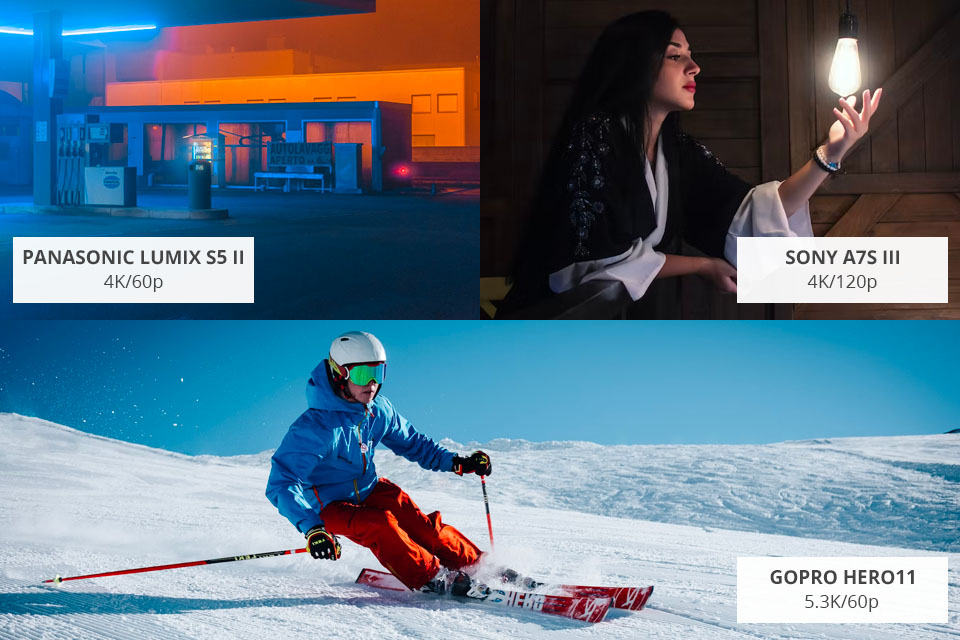
The Panasonic Lumix S5 II attracts videographers with its stunning cinematic features like 10-bit recording, V-Log, and V-Gamut profiles. So, this model is perfect for producing any footage, including commercial videos and travel vlogs.
The Sony A7S III beats the competitors with its ability to record high-quality videos in dark spaces. High-frame-rate shooting allows for shooting impressive cinematic, low-light, and documentary videography.
The GoPro Hero11 is an ideal solution for shooting action-packed footage. It is stuffed with features for recording fantastic films, like advanced stabilization for shooting action, sports, and adventure vlogging. This camera is easy to carry around and can be a good camera for sport even in low lighting scenarios.
It depends on what you are going to use it for. 4K offers four times more pixels than Full HD, so the result is crisper, clearer pics, and more flexible post-production workflow. This is also an ideal option for future-proofing your content. But if your viewers enjoy the content produced by you on small screens, Full HD is more than enough.
DSLRs offer decent video shooting performance, but mirrorless cameras really stand out when it comes to videography. They weigh less, have better autofocus, and many have options specifically designed for shooting films. However, if you already have a DSLR for video, it can cope with the job when paired with the right lens and configured properly.
Of course, many phone models record excellent videos. Some shooters even use a phone camera for professional purposes. However, serious filmmakers should definitely purchase the best camera for video that is fitted with better lenses, offers better image quality, and boasts excellent performance in low lighting conditions.
At the time of writing the article, the cheapest camera was the GoPro Hero11. Among mirrorless, the cheapest model was the Sony Alpha ZV-E10.
When I was writing the article, the most expensive camera was the Sony A7S III. This is a professional option for shooting in any lighting conditions.
YouTube vloggers usually shoot with mirrorless video cameras, as they are more compact, lightweight, and record content of the highest quality. Some of the YouTubers let their fans know what devices they use to record their vlogs. As a rule, they prefer models with a flip-out screen, so they can frame themselves up when shooting without an assistant.